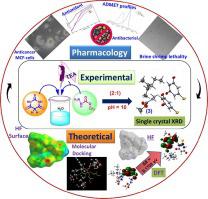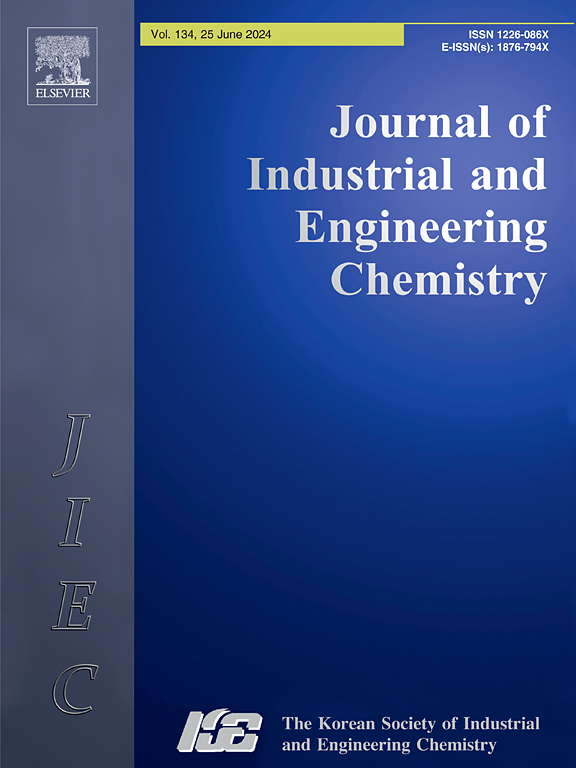肼盐:通过合成、表征、药理学和理论分析揭示其各种潜力
IF 5.9
3区 工程技术
Q1 CHEMISTRY, MULTIDISCIPLINARY
Journal of Industrial and Engineering Chemistry
Pub Date : 2025-01-25
DOI:10.1016/j.jiec.2024.06.026
引用次数: 0
摘要
本研究的重点是新合成的肼衍生物化合物,特别是肼酸甲酯(MCZ,CHNO)和 2-硫代巴比妥酸(2-TBA,CHNOS)。MCZ 和 2-TBA 反应生成了三种盐,其组成如下:(CHNO)(CHNOS)(CHNO)(CHNOS)(CHNO) ) 和 (CHNO)(CHN)(CHNOS) [(CHN)代表三乙基铵阳离子]。对所制备的盐进行了全面表征,结果表明化合物呈现单斜晶系结构,并符合利宾斯基规则,表明其具有显著的类药物特性。分子对接分析表明,这些化合物与细菌蛋白质有很强的结合亲和力,特别是和,这表明它们具有作为抗菌剂的潜力。DPPH 试验证明,合成的化合物具有显著的自由基清除能力。盐水虾致死试验、抗菌试验和 MCF-7 细胞系抗癌研究等药理评价结果表明,这些化合物具有非常显著的活性,尤其是细胞毒性作用,表明它们具有作为抗癌剂的潜力。该化合物是对 MCF-7 细胞最有效的抗癌剂。这些发现强调了这些化合物的广泛潜力,特别是作为具有显著抗菌、抗氧化和抗癌活性的药物,它们可能会在药物化学领域做出贡献,并对治疗应用产生影响。本文章由计算机程序翻译,如有差异,请以英文原文为准。


Hydrazine-derived salts: Unveiling their diverse potential through synthesis, characterization, pharmacology, and theoretical analysis
This study focuses on newly synthesized compounds derived from hydrazine derivatives, specifically methyl carbazate (MCZ, C2H6N2O2) and 2-thiobarbituric acid (2-TBA, C4H4N2O2S). The reaction between MCZ and 2-TBA resulted in the formation of three types of salts with the following compositions: [(C2H7N2O2)+(C4H3N2O2S)− (1), (C2H7N2O2)+(C4H3N2O2S)−(C2H6N2O2) (2), and (C2H7N2O2)+(C6H16N)+(C4H3N2O2S)2− (3) [(C6H16N)+ represents the triethyl ammonium cation]. The prepared salts were comprehensively characterized, showing that compound (3) exhibited a monoclinic crystal structure and met Lipinski’s rules, indicating significant drug-like properties. Molecular docking analysis revealed that these compounds exhibited strong binding affinities toward bacterial proteins, particularly Staphylococcus aureus and Escherichia coli, indicating their potential as antibacterial agents. The synthesized compounds demonstrated remarkable free radical-scavenging abilities, as evidenced by DPPH assays. The results of pharmacological evaluations, including brine shrimp lethality assays, antibacterial tests, and anticancer studies on MCF-7 cell lines, revealed that the compounds exhibit highly significant activities, particularly cytotoxic effects, suggesting their potential as anticancer agents. The compound (3) emerged as the most effective anticancer agent against MCF-7 cells. These findings underscore the broad potential of these compounds, especially (3), as promising agents with significant antibacterial, antioxidant, and anticancer activities, suggesting that they may contribute to the field of medicinal chemistry with implications for therapeutic applications.
求助全文
通过发布文献求助,成功后即可免费获取论文全文。
去求助
来源期刊
CiteScore
10.40
自引率
6.60%
发文量
639
审稿时长
29 days
期刊介绍:
Journal of Industrial and Engineering Chemistry is published monthly in English by the Korean Society of Industrial and Engineering Chemistry. JIEC brings together multidisciplinary interests in one journal and is to disseminate information on all aspects of research and development in industrial and engineering chemistry. Contributions in the form of research articles, short communications, notes and reviews are considered for publication. The editors welcome original contributions that have not been and are not to be published elsewhere. Instruction to authors and a manuscript submissions form are printed at the end of each issue. Bulk reprints of individual articles can be ordered. This publication is partially supported by Korea Research Foundation and the Korean Federation of Science and Technology Societies.

 求助内容:
求助内容: 应助结果提醒方式:
应助结果提醒方式:


